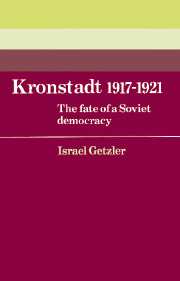Book contents
6 - Kronstadt's third revolution
Published online by Cambridge University Press: 29 September 2009
Summary
Kronstadt emerged relatively unscathed from the ravages of the civil war. Despite recurrent mobilizations, which drained the naval base and the fortress of thousands of its sailors and soldiers, and the evacuations of 1919, which reduced its civilian population, by January 1921 there were still over 50,000 people, military and civilian, living in Kronstadt. Indeed, with the evacuation of the larger part of the Baltic Fleet from Reval and Helsingfors to Kronstadt in March and April 1918 (under the terms of the Brest-Litovsk Treaty), it had become the fleet's main base. Nor had the composition of its population greatly changed. Nearly 27,000 sailors and soldiers manned its forts and fortifications, its naval depots, and the battleships moored in the harbour, notably Russia's two remaining Dreadnoughts, the Petropavlovsk and the Sevastopol, while a work-force of some 13,000 was employed in its docks, naval installations and workshops, the steamship plant, sawmill and electrical station.
Red Kronstadt was also regarded as a loyal stronghold of the Soviet regime and its Communist party, and its sailors, the renowned ‘Red Eagles’, had more than once been called to Petrograd to help in election campaigns, man roadblocks and quell mutiny, and were invoked as a praetorian threat to intimidate striking workers. Despite the crisis in the Communist party at the end of the civil war, and the rigorous local purge conducted by Fiodor Raskolnikov in the autumn of 1920, the Communist party organization remained strong in Kronstadt, with some 2,900 full members and 600 candidate members.
- Type
- Chapter
- Information
- Kronstadt 1917–1921The Fate of a Soviet Democracy, pp. 205 - 245Publisher: Cambridge University PressPrint publication year: 1983

